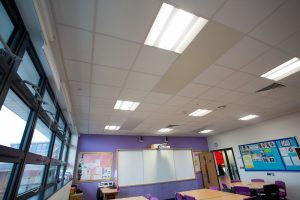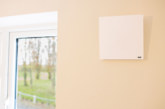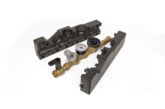
The use of radiant panels in schools is becoming more popular because they offer significant energy-saving benefits and create a safer, cleaner environment for pupils. But is it better to incorporate them within the ceiling or to have them free-hanging? It depends whether they are being installed in a new or existing school and whether the ceiling is open or tiled. Dave Jones, Radiant Product Manager at SPC, explains.
According to the Carbon Trust, space heating can account for nearly 60% of energy use in schools1. Therefore, implementing more modern technology to deliver thermal comfort to staff and pupils could go a long way towards reducing a school’s energy bills. In the past, radiant panels were not as widely used. But as educational establishments continue to face increasing financial pressures, many are recognising the role that radiant heating can play in reducing energy and maintenance costs. At the same time, acoustic attenuation — a key requirement to assist in effective teaching and learning — can be delivered without affecting heating performance.
Radiant heating panels can be retrofitted into existing buildings or installed into new premises. The decision whether to free-hang them or install them as part of a suspended system depends on the ceiling itself. Regardless of the installation method, there are important points to bear in mind.
Retrofitting
Many existing schools use false ceilings with fibre ceiling tiles. If the panels are being installed in such buildings to replace radiators or fan convectors, it would make sense to incorporate them into the false ceiling unless it is being removed. The presence of a false ceiling would preclude free-hanging radiant panels; there would not be enough space to mount them at a height, which optimises occupier comfort. By installing the panels into the ceiling grid, they can be connected to existing pipework, which is likely to be found in this part of the room.
“The size of the panels required is dependent on their mounting height, intensity (surface temperature to surface area/output) and layout, all of which have an impact on each other and on occupant comfort.”
However, this type of ceiling tile tends to be available as 600 by 600mm panels. Because the radiant panels simply replace the ceiling tiles in the gridwork, they would also need to be sized in multiples of 600mm, giving less design flexibility. When radiant panels are installed in a ceiling grid, it is also important to choose panels which have little or no sidewalls with the insulation right across the top surface. This ensures minimal loss of heat to the ceiling void and avoids the possibility of problems with other services.
New premises
Rather than using conventional ceiling tiles, new schools are increasingly using metal tiles or doing away with false ceilings altogether. Where a school prefers to have a false ceiling, metal tiles are becoming a popular choice because they do not warp or discolour as easily as those made from fibre. At the same time, acoustic insulation and lights can be added, and a wider variety of designs can be realised.
As with the case of conventional false ceiling systems, the metal tiles are simply replaced with radiant panels in the same space. However, because metal tiles are available in a much wider variety of sizes and shapes, the radiant panels can also be sized and shaped in different ways to suit requirements. This naturally opens up the number of possible designs; not only can the panels provide functional heating and cooling to a classroom, but they can also be presented as a design feature.
If the building has an open ceiling, radiant panels can be installed free-hanging from the soffit as a raft or sail and incorporate other services. Although they are not fitted into the ceiling, it is still advisable to use well-insulated panels to minimise unnecessary convection. The insulation in SPC’s Thermatile Plus totally seals the top surface of the panel. In addition, we can offer bespoke designed free hanging raft or sails in different shapes, sizes, acoustic patterns and colours, all of which can be finished with various edge details.

Specification and design
Regardless of the method of installation, careful thought should be put into the specification and selection of radiant panels. The size of the panels required is dependent on their mounting height, intensity (surface temperature to surface area/output) and layout, all of which have an impact on each other and on occupant comfort.
Firstly, modern heating systems that use technologies such as condensing boilers and ground source heat pumps operate with lower water temperatures. In addition, many heating controls can modulate water temperatures and flow rates to keep system temperatures low. This means that it is now possible to install larger, less intense radiant panels at lower mounting heights for optimum comfort levels. Indeed, this often delivers a more comfortable environment for occupiers.
Secondly, radiant panels emit their heat in a 45 degree cone, so a panel mounted at 3m will deliver heat to an area of 6 s/m. There are, however, varying intensities within the cone with the maximum intensity directly under the centre line of the panel. To ensure that the radiant panels distribute heat evenly through a room, the layout needs to incorporate small overlaps of these ‘cones’ of heat. This is easier to achieve by using more panels. This is worth bearing in mind if you are tempted to value-engineer the project by reducing the number of panels, as this could jeopardise occupier comfort even at the same level of heat input.
As budgets tighten on schools and colleges, the challenge to continue providing a comfortable learning environment without compromising on energy efficiency or aesthetics becomes ever steeper. Thankfully, modern heating products such as radiant panels offer a viable solution. By understanding how they are installed to work with the fabric of a building and the technicalities behind their correct specification, school managers can tick all the right boxes for both new and existing institutions.








